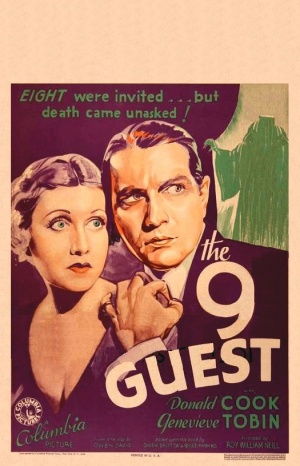
THE NINTH GUEST
US, 1934, 65 minutes, Black-and-white.
Donald Cook, Genevieve Tobin, Hardie Albright, Edward Ellis, Edwin Maxwell, Helen Flint, Samuel S Hinds.
Directed by R.William Neil.
This is one of the many one hour or a little longer second feature films that were so popular in the 1930s and into the 1940s. This certainly is one of the better ones, worth seeing.
Audiences familiar with Agatha Christies Ten Little Niggers Figures/Ten Little Indians/And Then There Were None, may guess what has happened that may have to guess all work out who was responsible. However, Agatha Christie’s story was published five years after this film which is based on a play and a novel by and Davies.
It uses the familiar conventions of old dark house thrillers. While the guests here, eight of them, have to come at night to an appointment at an After Deco home, there is both light and darkness in this house. The film spends a lot of time showing the range of guests and their all receiving a telegram inviting them to the house. We see them once again as they arrive at the house, but this time with more background. None of them knows why they have been invited or who invited them.
When nothing happens, some want to leave, but they find that the doors are locked and electrified and at the time appointed, the voice comes over the radio, threatening them with death. Times are also given for the deaths. The only other characters are a butler and a mysterious yet comic, and drunk character, who is an electrician – and audiences are suspicion of these two.
There is a wealthy man who has manipulated politics, is in league with the seemingly upright doctor, and who is quite bigoted in himself. He uses a ruse in order to poison all the characters – but cuts himself on a piece of metal with the poison and is the first to die. A society woman who has flaunted her snobbery is exposed as a bigamist and kills herself. There is also the editor of the paper, antagonistic towards the manipulator of politicians, arrogant in himself, and he is killed as well as is his wife who runs into the electrification. The respectable doctor, who has urged against the employment of one of the guests, is then murdered, leaving the heroine, suspicious of the two remaining men, wanting to leave, but hearing all the broadcasts from their host.
He explains to them that the ninth guest is death.
One of the men, a journalist was devoted to the leading lady and has grown up with her, begins to unravel some of the clues, especially finding that the radio broadcasts were actually recordings set to play at specific times. The murderer is clearly one of the two men but the journalists is able to unmask the man who did not get his job at the University, who is infatuated with the leading lady, and has grudges against all those who have been killed. He says he would play fair and not kill anyone who worked out to the murderer was – and he goes to his death.
The work of the character actors who dramatise their complicated lives is more impressive than the performances of the leads. The screenplay is quite ingenious in its way, making sure that all the angles are covered, the gates being electrified, no way out, the working of the radio and the broadcasts…
The film was directed by Roy William Neil was to go on to direct most of the Basil Rathbone- Nigel Bruce Sherlock Holmes films during the 1940s. He died in 1946 just as the Sherlock Holmes series was ending.